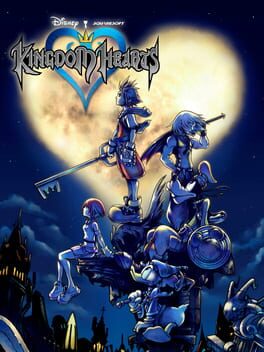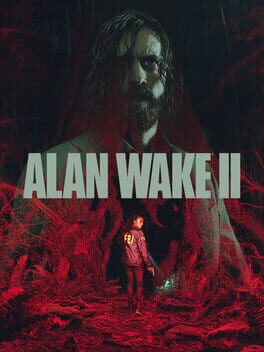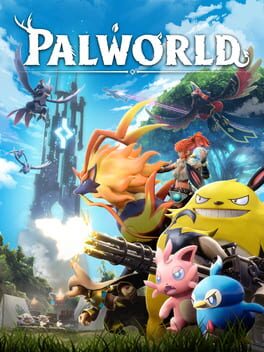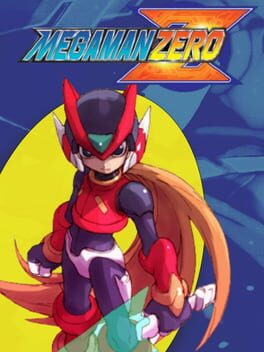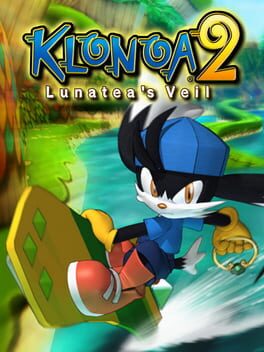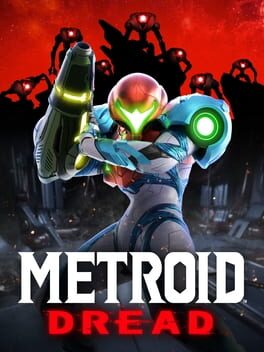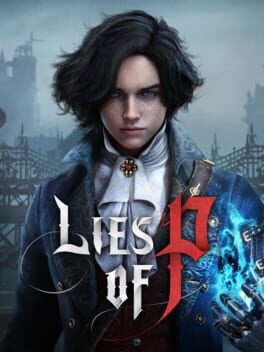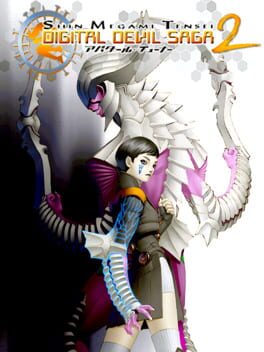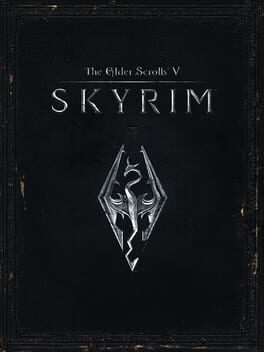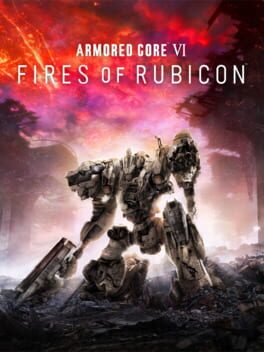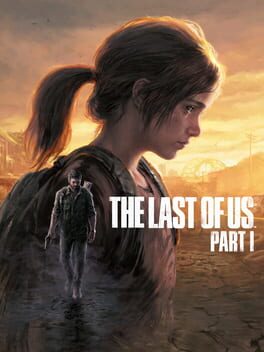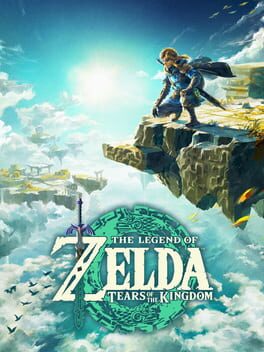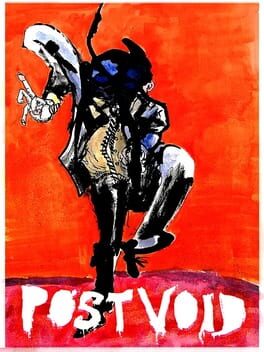killnetic
46 Reviews liked by killnetic
Kingdom Hearts
2002
Alan Wake II
2023
This review contains spoilers
riverrun, past Eve and Adam’s, from swerve of shore to bend of bay, brings us by a commodius vicus of recirculation back to Howth Castle and Environs. [...] Loonely in me loneness. For al their faults. I am passing out. O bitter ending! I’l slip away before they’re up. They’l never see. Nor know. Nor miss me. And it’s old and old it’s sad and old it’s sad and weary I go back to you, my cold father, my cold mad father, my cold mad feary father, til the near sight of the mere size of him, the moyles and moyles of it, moananoaning, makes me seasilt saltsick and I rush, my only, into your arms. I see them rising! Save me from those therrble prongs! Two more. Onetwo moremens more. So. Avelaval. My leaves have drifted from me. Al . But one clings stil . I’l bear it on me. To remind me of. Lff! So soft this morning, ours. Yes. Carry me along, taddy, like you done through the toy fair! If I seen him bearing down on me now under whitespread wings like he’d come from Arkangels, I sink I’d die down over his feet, humbly dumbly, only to washup. Yes, tid. There’s where. First. We pass through grass behush the bush to. Whish! A gul . Gul s. Far cal s. Coming, far! End here. Us then. Finn, again! Take. Bussoftlhee, mememormee! Til thous-endsthee. Lps. The keys to. Given ! A way a lone a last a loved a long the
Palworld
2024
Palworld
2024
Mega Man Zero
2002
The First hours: AHAHAHAH SWEET. I´M A WEIRD CATY-KITTY-BUNNY THING WITH LONG EARS AND A PAC-MAN ON HIS CAP AHAHAH YEEEHAA
The Last Hours: https://www.youtube.com/watch?v=6EfStVCU01A
One of the finest examples of platforms used to worldbuilding and storytelling
The Last Hours: https://www.youtube.com/watch?v=6EfStVCU01A
One of the finest examples of platforms used to worldbuilding and storytelling
Metroid Dread
2021
Lies of P
2023
There's a great sense of cheapness about the whole thing that seems to come from a lack of internal cohesion: there's something heterogeneous about the animations, the different art assets, the awkwardly translated item descriptions and the Crunchyroll dub voice-acting. Everything feels cobbled together, and this feeling's heightened by the way it appropriates so many aspects of Bloodborne without much consideration for the overall effect that game achieves with them.
There's something sympathetic about any piece of media whose goal is to be just as good as another, driven by a kind of scrappy acquisitiveness that insists it needs neither talent nor originality to succeed. However they de-Italianized Pinocchio which is unforgivable.
There's something sympathetic about any piece of media whose goal is to be just as good as another, driven by a kind of scrappy acquisitiveness that insists it needs neither talent nor originality to succeed. However they de-Italianized Pinocchio which is unforgivable.
Those who see art as a shortcut to prestige have a very distorted idea of what is "prestigious" - Look Kojima, creating spiritual connections through eschatology, total genius -, And few of this horrible ilk exist like Neil druckmann or conrad roset. Guys who use the medium of video games as a platform to satisfy their hunger for prominence and recognition. and incidentally, along the way, dividing in a problematic way the reception and conception of "arthouse" and pop games
I'm not going to blame them for Little Nightmares being read as an empty and morbid trip, because before that there was Playdead with his Limbo.
Neither of the obsession with the tone and fixation with photorealism without a plastic sense more typical than seeing the pores of Nathan Drake's skin, but, God, how I would like a timeline in which Roset and Druckmann are considered the worst in a way unanimous. Because they may not be the worst in general in the horror pile, but their popularity exposes the sad reality that some are interested in video games being validated by those who do not appreciate them in all their aspects, and those who need them to carry an HBO series cosplay or Milanese exhibition box
____________________
the idea of how necessary any author was -beyond programmers- in videogames came to me for the first time playing Dragon Quarter "the shape of this game does not seem to be the product of chance or trends" said little Ardu at one time where he assumed that experimentation was the standard and the methodology to follow, the correct choice. Poor ignorant little Ardu.
In 2013 Little Ardu also said: "In the same year as Attack of the friday monsters, Drakengard 3, TW101, Proteus and Resogun... There is The Last of Us, this game that has enchanted me for its solidity and surprising humanity ( little Ardu didn't see that coming) but it's also the pinnacle of the formally conservative tv prestige show wannabe game type, which seems to be the way forward for pop games. mmmm maybe it's not that bad either? I mean it has overlapped many games that I consider better, but that always happens to me haha if one day justice will be done, but meanwhile, if the AAA are like that, maybe we will advance something "
Poor ignorant little Ardu.
I'm not going to blame them for Little Nightmares being read as an empty and morbid trip, because before that there was Playdead with his Limbo.
Neither of the obsession with the tone and fixation with photorealism without a plastic sense more typical than seeing the pores of Nathan Drake's skin, but, God, how I would like a timeline in which Roset and Druckmann are considered the worst in a way unanimous. Because they may not be the worst in general in the horror pile, but their popularity exposes the sad reality that some are interested in video games being validated by those who do not appreciate them in all their aspects, and those who need them to carry an HBO series cosplay or Milanese exhibition box
____________________
the idea of how necessary any author was -beyond programmers- in videogames came to me for the first time playing Dragon Quarter "the shape of this game does not seem to be the product of chance or trends" said little Ardu at one time where he assumed that experimentation was the standard and the methodology to follow, the correct choice. Poor ignorant little Ardu.
In 2013 Little Ardu also said: "In the same year as Attack of the friday monsters, Drakengard 3, TW101, Proteus and Resogun... There is The Last of Us, this game that has enchanted me for its solidity and surprising humanity ( little Ardu didn't see that coming) but it's also the pinnacle of the formally conservative tv prestige show wannabe game type, which seems to be the way forward for pop games. mmmm maybe it's not that bad either? I mean it has overlapped many games that I consider better, but that always happens to me haha if one day justice will be done, but meanwhile, if the AAA are like that, maybe we will advance something "
Poor ignorant little Ardu.
'Rui, do people’s hearts forget how to react to a town that leaves nothing behind to remember it by? In comparison, there is something cruel, merciless about the sight of the Sanriku region, where everyday life was transformed into ruins. For that mountain of debris was the “hope” people had spent years building.'
– Kyōko Hayashi, Futatabi Rui e, 2013 (tr. Margaret Mitsutani).
Kyōko Hayashi's works attempt to convey to younger generations the lived experience of the hibakusha, the direct survivors of the atomic bombings of Hiroshima and Nagasaki. A particular feature of her work is the blending of temporalities and events, which illustrates her chaotic and almost unspeakable recollection of the events of the 9 August 1945. In Futatabi Rui e (2013), Hayashi writes a new letter to Rui – following the one included in Torinitii kara torinitii e (2000) – meditating on the effects of the Great East Japan Earthquake and the Fukushima disaster. She writes: 'perhaps the Great East Japan Earthquake was what turned this destruction in the natural world I thought was eternal into a sign that everything I’d believed in was now crumbling before my eyes' [1].
Disasters and environmentalism in Japanese fiction
The atomic bombings and the Fukushima disaster have had a lasting impact on Japanese cultural production, like a never-ending ghost that is periodically fanned by current events. Fumiyo Kōno's Yunagi no machi, sakura no kuni (2003) illustrates this concern in a multi-generational story. It is a cathartic narrative whose main purpose is to nurture and reconcile the painful memory for the hibakusha, but also for those who did not directly witness the events. The acceleration of climate change and Japan's new energy mix are also of growing concern, conjuring up an image of a Japan on the brink of extinction and ravaged by disasters. Two examples illustrate the epidermal nature of these issues. In 2014, the famous gourmet manga Oishinbo (1983) tackled the aftermath of the Fukushima disaster head-on, highlighting the harmful effects on the environment and the people of the region, who suffered regular nosebleeds. These scenes clashed with the official discourse on the effects of the accident, so much so that Shinzo Abe directly condemned the manga [2], leading to the series' ongoing hiatus.
More recently, Makoto Shinkai's films have oscillated between neo-traditionalism and social conservatism, as in Tenki no Ko (2019). Maria Mihaela Grajdian has already pointed out that Mamoru Hosoda's films, by idealising concepts such as family, parenthood and masculinity, 'shows both that he understands the critical situation and that he does not regard it as his duty to offer alternative solutions, more in tune with the spirit of the 21st century' [3]. In Tenki no Ko, Shinkai is content with the same naive, depoliticising position: climate change and the disappearance of Japan under the sea are seen as inevitable natural phenomena, and the film prefers to focus on the fleeting happiness of a few teenagers from a purely individualistic, conservative perspective.
With The Legend of Zelda: Breath of the Wild (2017), Nintendo's flagship series has also taken up these themes anew. This is less a first exploration than an updated discourse. The Zelda games have always contained elements of shintō philosophy, contrasting Arthurian mythology with the typically Japanese depiction of environments, whether through non-human creatures, the abundance of islands – literal or figurative – or the sacred aspect of nature. Breath of the Wild depicted the world after a catastrophe and the restoration of nature, everlasting despite the scars left by disasters. Tears of the Kingdom is a direct reflection of this vision, by reversing the representation.
Flowers of ruin: looking at micro-gardens
A variation on the theme of Majora's Mask (2000), Tears of the Kingdom also shows humanity on the brink of extinction. However, the tone is quite different. Whereas Majora's Mask was a journey into nihilism and the lack of communication that breaks down interpersonal relationships, Tears of the Kingdom explores the persistence of solidarity and the opening up of societies. Recontextualised, the world of Hyrule is a fable that sings of the resilience of nations in the face of natural disaster. Even within the first few hours of surface exploration, the world is teeming with life, yet societies live hidden away, sheltered from the elements. There is something charming about re-exploring a world that is decidedly optimistic, but still a little fearful, like the first buds of spring breaking through the snow.
Rather tellingly, the Zonai Ruins are still harbouring life: the sky islands are still inhabited by birds, while the debris that has fallen to the ground is home to plants that normally only grow in the heavens. Despite these chaotic elements, however, the world of Hyrule is somewhat more domesticated. The roads are well trodden by travellers, stables provide regular resting places, and construction materials are plentiful along the roadsides. Tears of the Kingdom has swapped the 'miniature plant garden' and 'garden in a box' (hakoniwa) [4] for a lusher shrubland. Hyrule is shaped by the collaborative work of its inhabitants, and their presence can be seen in the little accents that dot the landscape: Zelda and Magda's little flower garden, or Pyper's glittering tree, are clear signs that humans have made the environment their own, creating a symbiotic relationship between society and nature.
Tears of the Kingdom is, in a way, an ode to primordialism and man's passivity when it comes to influencing nature. Unlike Breath of the Wild, where the equipment forged by humans quickly becomes the most powerful, the player can make do with items found on monsters for most of the adventure. It's not until fairly late in the game that the shift occurs, when Zonai items can become more valuable. More generally, Tears of the Kingdom allows the player to contemplate the world and its inhabitants through tighter resource management, at least in the first few dozen hours. But even when Link is well equipped, nature is not easily tamed, as the introduction of world bosses keeps exploration somewhat terrifying or majestic. The exploration of the Depths, while often undermined by visual monotony, illustrates the sinister nature of what crawls beneath the gaze of the living, and the importance of ruin, not just of human civilisations, but of a world tainted by corruption (kegare).
A melancholic sky: fall and burden as elements of game design
This aesthetic owes a great deal to the vision of Hidemaro Fujibayashi and Daiki Iwamoto, given that they apprehend the sky through the act of falling. There is a certain tragic irony to this Upheaval, as it is used to discover the reasons for the fall of the Zonai. As in Skyward Sword (2011), the exploration of the skies begins with a long fall. But the world of Skyward Sword allows for much easier exploration thanks to its bird mounts [5], whereas in Tears of the Kingdom Link is constantly being pulled down by gravity. He is destined to fall, and this sense of heaviness is present throughout the game: in particular, the interactions with the various inhabitants of the world emphasise their insecurity and, by extension, their fallibility. Despite the humour and joviality that runs through the dialogue, all the characters are undermined by self-imposed desires and missions. Addison continues to hold signs for endless days, Reede is forced to admit that his vision of tranquillity is no longer sustainable, and Penn struggles with his fear of actively participating in field investigation. There is something deeply human about them, and Link emerges in turn as a mythologised figure as he performs heroic deeds and helps others. In this respect, it is striking that everyone knows his name, but his identity sometimes remains a mystery.
This philosophy no doubt helps to explain other design elements and Fujibayashi's characteristic wandering. Tears of the Kingdom opts for a more scripted progression, with the player openly encouraged to help the various tribes. Each storyline is fairly engaging and recontextualises nicely the characters met in Breath of the Wild – with the exception of the Goron quest, which neutralises its anti-capitalist themes far too quickly. The main quests in each region are refreshingly varied, with some unexpected sequences such as the defence of Gerudo Town. The downside of this approach is the disappointment of the dungeons. These are particularly mediocre, a simple series of puzzles inferior to those in the Shrines. The same structure as The Minish Cap (2004) is found in Tears of the Kingdom, with an inability to think holistically about design. These sequences do a poor job of incorporating the great freedom of Link's powers; it would probably have been more interesting to emphasise the oppressive aspect of confined spaces and a survival approach, for example by removing the map in dungeons.
As it stands, the non-linearity of the title works against many of the design ideas. In addition to the identical flashbacks for each Sage, the dungeons do not adapt well to the upscaling that players experience as they accumulate more resources and power. For the most part, the dungeons restrict the new skills unlocked, rather than showcasing them as other mini-dungeons and celestial islands can, where Ultrahand shines very brightly. The Fire Temple is perhaps the only exception, as it is possible to completely ignore the various puzzles if the player has enough resources and has been diligent in their exploration. On the other hand, the non-linearity works well with the side quests, as it feels genuinely satisfying when an NPC tells Link that he has already completed the mission he was given. Similarly, the Proving Grounds Shrines benefit greatly from player progression and a larger heart pool, turning a careful experience into a speed challenge, while the other Shrines allow for creative expression for players familiar with the advanced grammar of the various powers and machines.
Perhaps more importantly, it is the combat that suffers greatly from this approach: while Tears of the Kingdom features much larger waves of enemies, the system remains clunky. The combat system is designed for duels rather than large-scale melee, and the lack of ergonomics often renders Fuse unusable in battle. Similarly, the Sages' avatars are a welcome touch, emphasising the fact that Link is no longer alone, but the implementation is so unpleasant that it is easier to ignore their powers outside of certain puzzles. To a certain extent, the heaviness of the game and the idea of the fall serve to underline a contemplation of the world and its societies, provided one is receptive to Fujibayashi and Iwamoto's themes, but at the expense of the gameplay and the fluidity of the experience.
To live is to atone for one's sins: neo-traditionalism in Japan
Breath of the Wild had already begun to return to a very Japanese aesthetic, a trend that continues in Tears of the Kingdom. Certain elements are obvious: Kakariko Village retains the same visual appearance, and the soundtrack features many more Asian elements – 'Master Kohga Battle' makes more use of the shamisen, and the 'Main Theme' is largely driven by an erhu, to name just two examples. Thematically, the universe more readily embraces East Asian mythology. Dragons are explicitly Japanese, as are the quest for immortality, magatama, the constant search for home (ibasho), and the genealogical links between humanity and the gods – the royalty of Hyrule is descended from the union of Zonai and humans, just as Emperor Jimmu is described as a descendant of Amaterasu.
Strikingly, the noble female characters in Tears of the Kingdom are all marked by the Japanese stain of tragedy, whether through the burden of blood, motherhood or the sins for which they take responsibility. The thematic development and presentation of Rauru and Sonia form a striking parallel with Izanagi and Izanami. As parental figures, the royal couple represents a familial and affective ideal, albeit a highly traditional one. Despite its seemingly progressive themes, Tears of the Kingdom revels in social stagnation and a status quo that must be protected at all costs – the True Ending emphasises that the point was not just to defeat Ganondorf, but to preserve 'eternal peace' (eien no an'nei) [6]. Hyrule may have undergone a number of transformations since Breath of the Wild, but they have always occurred within continuities: clan leaders have changed, but only to be replaced by blood descendants. Similarly, the multicultural discourse is always tempered by the service that the different tribes provide to the Hylian royalty, according to a strict hierarchy.
Tears of the Kingdom is a parenthesis and a intermediary conclusion to the series. At the end of the adventure, Link returns the powers he used to explore the world. The gameplay of the title is designed to be a natural extension of the powers used in Breath of the Wild, increasing the creative and traversal possibilities. It is, however, a temporary experience; to the player, Tears of the Kingdom repeats the same old message: 'this is what I propose, and if you do not like it, so be it'. The title makes no concessions in its approach, to the point where it suffers structurally. Its extraordinary density may seem almost antiquated – but such has been Fujibayashi's legacy since The Minish Cap – and some will find the idea of the game providing bits and pieces of the solution to every puzzle heavy-handed.
Hyrule is still scarred by the damage of the Upheaval; there is no sign of the islands falling to the ground again, nor does Hyrule Castle. The Chasms are unlikely to close either, with only the Gloom gone. Mankind will have to learn to live with this new and distorted world. Like Japanese disaster fiction, Tears of the Kingdom looks to the future – to the resilience of the people – but it also reflects on the trauma that will not fade away: Kyōko Hayashi laments the inaction of institutions while the traces of destruction are still present in Japan, and the promise of the Sages at the very end of the game seems to be a response to this concern. Tears of the Kingdom guides the player's gaze almost relentlessly towards a contemplation of Japanese society in its environment, even if it means verging on the artificial, and whether or not this approach is welcomed is up to the player.
__________
[1] Kyōko Hayashi, 'To Rui, Once Again', tr. Margaret Mitsutani, in The Asia-Pacific Journal, vol. 15-7, no. 3, 2017, p. 3.
[2] Justin McCurry, 'Gourmet manga stirs up storm after linking Fukushima to nosebleeds', in The Guardian, 22nd May 2014, consulted on 10th July 2023.
[3] Maria Mihaela Grajdian, 'Compassionate Neo-Traditionalism in Hosoda Mamoru’s Animation Movies', in Russian Japanology Review, vol. 3, no. 2, 2020, p. 148.
[4] Victor Moisan, Zelda : Le jardin et le monde, Façonnage, Lyon, 2021.
[5] On spatiality, the traversal aspect and the design of the sky and Skyloft, see 'Volume Five: The Dense Sky and Town', in Nintendo, Iwata Asks – The Legend of Zelda: Skyward Sword, 2011.
[6] Note that the English translation conveys the original idea slightly differently, balancing Ganondorf's defeat with the idea of 'eternal peace'. The Japanese text reads: 「あの方たちが願ったのはつかまあ束の間ではなく永遠に続くハイラルの安寧。」Here, the comparison is much more focused on the ephemeral and the eternal, while the term 安寧 expresses both Hyrule's public peace and Zelda's inner tranquillity.
– Kyōko Hayashi, Futatabi Rui e, 2013 (tr. Margaret Mitsutani).
Kyōko Hayashi's works attempt to convey to younger generations the lived experience of the hibakusha, the direct survivors of the atomic bombings of Hiroshima and Nagasaki. A particular feature of her work is the blending of temporalities and events, which illustrates her chaotic and almost unspeakable recollection of the events of the 9 August 1945. In Futatabi Rui e (2013), Hayashi writes a new letter to Rui – following the one included in Torinitii kara torinitii e (2000) – meditating on the effects of the Great East Japan Earthquake and the Fukushima disaster. She writes: 'perhaps the Great East Japan Earthquake was what turned this destruction in the natural world I thought was eternal into a sign that everything I’d believed in was now crumbling before my eyes' [1].
Disasters and environmentalism in Japanese fiction
The atomic bombings and the Fukushima disaster have had a lasting impact on Japanese cultural production, like a never-ending ghost that is periodically fanned by current events. Fumiyo Kōno's Yunagi no machi, sakura no kuni (2003) illustrates this concern in a multi-generational story. It is a cathartic narrative whose main purpose is to nurture and reconcile the painful memory for the hibakusha, but also for those who did not directly witness the events. The acceleration of climate change and Japan's new energy mix are also of growing concern, conjuring up an image of a Japan on the brink of extinction and ravaged by disasters. Two examples illustrate the epidermal nature of these issues. In 2014, the famous gourmet manga Oishinbo (1983) tackled the aftermath of the Fukushima disaster head-on, highlighting the harmful effects on the environment and the people of the region, who suffered regular nosebleeds. These scenes clashed with the official discourse on the effects of the accident, so much so that Shinzo Abe directly condemned the manga [2], leading to the series' ongoing hiatus.
More recently, Makoto Shinkai's films have oscillated between neo-traditionalism and social conservatism, as in Tenki no Ko (2019). Maria Mihaela Grajdian has already pointed out that Mamoru Hosoda's films, by idealising concepts such as family, parenthood and masculinity, 'shows both that he understands the critical situation and that he does not regard it as his duty to offer alternative solutions, more in tune with the spirit of the 21st century' [3]. In Tenki no Ko, Shinkai is content with the same naive, depoliticising position: climate change and the disappearance of Japan under the sea are seen as inevitable natural phenomena, and the film prefers to focus on the fleeting happiness of a few teenagers from a purely individualistic, conservative perspective.
With The Legend of Zelda: Breath of the Wild (2017), Nintendo's flagship series has also taken up these themes anew. This is less a first exploration than an updated discourse. The Zelda games have always contained elements of shintō philosophy, contrasting Arthurian mythology with the typically Japanese depiction of environments, whether through non-human creatures, the abundance of islands – literal or figurative – or the sacred aspect of nature. Breath of the Wild depicted the world after a catastrophe and the restoration of nature, everlasting despite the scars left by disasters. Tears of the Kingdom is a direct reflection of this vision, by reversing the representation.
Flowers of ruin: looking at micro-gardens
A variation on the theme of Majora's Mask (2000), Tears of the Kingdom also shows humanity on the brink of extinction. However, the tone is quite different. Whereas Majora's Mask was a journey into nihilism and the lack of communication that breaks down interpersonal relationships, Tears of the Kingdom explores the persistence of solidarity and the opening up of societies. Recontextualised, the world of Hyrule is a fable that sings of the resilience of nations in the face of natural disaster. Even within the first few hours of surface exploration, the world is teeming with life, yet societies live hidden away, sheltered from the elements. There is something charming about re-exploring a world that is decidedly optimistic, but still a little fearful, like the first buds of spring breaking through the snow.
Rather tellingly, the Zonai Ruins are still harbouring life: the sky islands are still inhabited by birds, while the debris that has fallen to the ground is home to plants that normally only grow in the heavens. Despite these chaotic elements, however, the world of Hyrule is somewhat more domesticated. The roads are well trodden by travellers, stables provide regular resting places, and construction materials are plentiful along the roadsides. Tears of the Kingdom has swapped the 'miniature plant garden' and 'garden in a box' (hakoniwa) [4] for a lusher shrubland. Hyrule is shaped by the collaborative work of its inhabitants, and their presence can be seen in the little accents that dot the landscape: Zelda and Magda's little flower garden, or Pyper's glittering tree, are clear signs that humans have made the environment their own, creating a symbiotic relationship between society and nature.
Tears of the Kingdom is, in a way, an ode to primordialism and man's passivity when it comes to influencing nature. Unlike Breath of the Wild, where the equipment forged by humans quickly becomes the most powerful, the player can make do with items found on monsters for most of the adventure. It's not until fairly late in the game that the shift occurs, when Zonai items can become more valuable. More generally, Tears of the Kingdom allows the player to contemplate the world and its inhabitants through tighter resource management, at least in the first few dozen hours. But even when Link is well equipped, nature is not easily tamed, as the introduction of world bosses keeps exploration somewhat terrifying or majestic. The exploration of the Depths, while often undermined by visual monotony, illustrates the sinister nature of what crawls beneath the gaze of the living, and the importance of ruin, not just of human civilisations, but of a world tainted by corruption (kegare).
A melancholic sky: fall and burden as elements of game design
This aesthetic owes a great deal to the vision of Hidemaro Fujibayashi and Daiki Iwamoto, given that they apprehend the sky through the act of falling. There is a certain tragic irony to this Upheaval, as it is used to discover the reasons for the fall of the Zonai. As in Skyward Sword (2011), the exploration of the skies begins with a long fall. But the world of Skyward Sword allows for much easier exploration thanks to its bird mounts [5], whereas in Tears of the Kingdom Link is constantly being pulled down by gravity. He is destined to fall, and this sense of heaviness is present throughout the game: in particular, the interactions with the various inhabitants of the world emphasise their insecurity and, by extension, their fallibility. Despite the humour and joviality that runs through the dialogue, all the characters are undermined by self-imposed desires and missions. Addison continues to hold signs for endless days, Reede is forced to admit that his vision of tranquillity is no longer sustainable, and Penn struggles with his fear of actively participating in field investigation. There is something deeply human about them, and Link emerges in turn as a mythologised figure as he performs heroic deeds and helps others. In this respect, it is striking that everyone knows his name, but his identity sometimes remains a mystery.
This philosophy no doubt helps to explain other design elements and Fujibayashi's characteristic wandering. Tears of the Kingdom opts for a more scripted progression, with the player openly encouraged to help the various tribes. Each storyline is fairly engaging and recontextualises nicely the characters met in Breath of the Wild – with the exception of the Goron quest, which neutralises its anti-capitalist themes far too quickly. The main quests in each region are refreshingly varied, with some unexpected sequences such as the defence of Gerudo Town. The downside of this approach is the disappointment of the dungeons. These are particularly mediocre, a simple series of puzzles inferior to those in the Shrines. The same structure as The Minish Cap (2004) is found in Tears of the Kingdom, with an inability to think holistically about design. These sequences do a poor job of incorporating the great freedom of Link's powers; it would probably have been more interesting to emphasise the oppressive aspect of confined spaces and a survival approach, for example by removing the map in dungeons.
As it stands, the non-linearity of the title works against many of the design ideas. In addition to the identical flashbacks for each Sage, the dungeons do not adapt well to the upscaling that players experience as they accumulate more resources and power. For the most part, the dungeons restrict the new skills unlocked, rather than showcasing them as other mini-dungeons and celestial islands can, where Ultrahand shines very brightly. The Fire Temple is perhaps the only exception, as it is possible to completely ignore the various puzzles if the player has enough resources and has been diligent in their exploration. On the other hand, the non-linearity works well with the side quests, as it feels genuinely satisfying when an NPC tells Link that he has already completed the mission he was given. Similarly, the Proving Grounds Shrines benefit greatly from player progression and a larger heart pool, turning a careful experience into a speed challenge, while the other Shrines allow for creative expression for players familiar with the advanced grammar of the various powers and machines.
Perhaps more importantly, it is the combat that suffers greatly from this approach: while Tears of the Kingdom features much larger waves of enemies, the system remains clunky. The combat system is designed for duels rather than large-scale melee, and the lack of ergonomics often renders Fuse unusable in battle. Similarly, the Sages' avatars are a welcome touch, emphasising the fact that Link is no longer alone, but the implementation is so unpleasant that it is easier to ignore their powers outside of certain puzzles. To a certain extent, the heaviness of the game and the idea of the fall serve to underline a contemplation of the world and its societies, provided one is receptive to Fujibayashi and Iwamoto's themes, but at the expense of the gameplay and the fluidity of the experience.
To live is to atone for one's sins: neo-traditionalism in Japan
Breath of the Wild had already begun to return to a very Japanese aesthetic, a trend that continues in Tears of the Kingdom. Certain elements are obvious: Kakariko Village retains the same visual appearance, and the soundtrack features many more Asian elements – 'Master Kohga Battle' makes more use of the shamisen, and the 'Main Theme' is largely driven by an erhu, to name just two examples. Thematically, the universe more readily embraces East Asian mythology. Dragons are explicitly Japanese, as are the quest for immortality, magatama, the constant search for home (ibasho), and the genealogical links between humanity and the gods – the royalty of Hyrule is descended from the union of Zonai and humans, just as Emperor Jimmu is described as a descendant of Amaterasu.
Strikingly, the noble female characters in Tears of the Kingdom are all marked by the Japanese stain of tragedy, whether through the burden of blood, motherhood or the sins for which they take responsibility. The thematic development and presentation of Rauru and Sonia form a striking parallel with Izanagi and Izanami. As parental figures, the royal couple represents a familial and affective ideal, albeit a highly traditional one. Despite its seemingly progressive themes, Tears of the Kingdom revels in social stagnation and a status quo that must be protected at all costs – the True Ending emphasises that the point was not just to defeat Ganondorf, but to preserve 'eternal peace' (eien no an'nei) [6]. Hyrule may have undergone a number of transformations since Breath of the Wild, but they have always occurred within continuities: clan leaders have changed, but only to be replaced by blood descendants. Similarly, the multicultural discourse is always tempered by the service that the different tribes provide to the Hylian royalty, according to a strict hierarchy.
Tears of the Kingdom is a parenthesis and a intermediary conclusion to the series. At the end of the adventure, Link returns the powers he used to explore the world. The gameplay of the title is designed to be a natural extension of the powers used in Breath of the Wild, increasing the creative and traversal possibilities. It is, however, a temporary experience; to the player, Tears of the Kingdom repeats the same old message: 'this is what I propose, and if you do not like it, so be it'. The title makes no concessions in its approach, to the point where it suffers structurally. Its extraordinary density may seem almost antiquated – but such has been Fujibayashi's legacy since The Minish Cap – and some will find the idea of the game providing bits and pieces of the solution to every puzzle heavy-handed.
Hyrule is still scarred by the damage of the Upheaval; there is no sign of the islands falling to the ground again, nor does Hyrule Castle. The Chasms are unlikely to close either, with only the Gloom gone. Mankind will have to learn to live with this new and distorted world. Like Japanese disaster fiction, Tears of the Kingdom looks to the future – to the resilience of the people – but it also reflects on the trauma that will not fade away: Kyōko Hayashi laments the inaction of institutions while the traces of destruction are still present in Japan, and the promise of the Sages at the very end of the game seems to be a response to this concern. Tears of the Kingdom guides the player's gaze almost relentlessly towards a contemplation of Japanese society in its environment, even if it means verging on the artificial, and whether or not this approach is welcomed is up to the player.
__________
[1] Kyōko Hayashi, 'To Rui, Once Again', tr. Margaret Mitsutani, in The Asia-Pacific Journal, vol. 15-7, no. 3, 2017, p. 3.
[2] Justin McCurry, 'Gourmet manga stirs up storm after linking Fukushima to nosebleeds', in The Guardian, 22nd May 2014, consulted on 10th July 2023.
[3] Maria Mihaela Grajdian, 'Compassionate Neo-Traditionalism in Hosoda Mamoru’s Animation Movies', in Russian Japanology Review, vol. 3, no. 2, 2020, p. 148.
[4] Victor Moisan, Zelda : Le jardin et le monde, Façonnage, Lyon, 2021.
[5] On spatiality, the traversal aspect and the design of the sky and Skyloft, see 'Volume Five: The Dense Sky and Town', in Nintendo, Iwata Asks – The Legend of Zelda: Skyward Sword, 2011.
[6] Note that the English translation conveys the original idea slightly differently, balancing Ganondorf's defeat with the idea of 'eternal peace'. The Japanese text reads: 「あの方たちが願ったのはつかまあ束の間ではなく永遠に続くハイラルの安寧。」Here, the comparison is much more focused on the ephemeral and the eternal, while the term 安寧 expresses both Hyrule's public peace and Zelda's inner tranquillity.
Mesocore madness.
probably the first comedy game apart Takeshi no Chōsenjō.
People can argue that the high difficulty is artificial.
Gamers ,probably.
But that difficulty is the product of the inventiveness of the level design, which does not care shit about the player.
Much of the Japanese action games orbit around the dominance of a body or mechanics, then the player is pleased.
Not here, here you are nothing.
probably the first comedy game apart Takeshi no Chōsenjō.
People can argue that the high difficulty is artificial.
Gamers ,probably.
But that difficulty is the product of the inventiveness of the level design, which does not care shit about the player.
Much of the Japanese action games orbit around the dominance of a body or mechanics, then the player is pleased.
Not here, here you are nothing.
Post Void
2020
With his head in hand, he who bore the pain, would try to reach The Void again; The place where nothing moves, where darkness is lord and silence its preacher - a place of peace.
as someone whose number one dream in life has been to clamber into a sensory deprivation tank for years now, i relate to post void's take on the arcade format. oblivion is inviolable and sacrosanct here, not transcendence - everything between here and that inverse nirvana is stream-of-consciousness anarchy and troublesome white noise, each new threat a tax and handicap on your senses as you try to reach that sweet, sweet cessation of being. so committed to 'noise' post void is that even your upgrades will occasionally contribute to the visual clutter on screen (one explodes enemies on death; another ricochets bullets), and it's up to you to translate that mess to wasd and mouse as you line up headshot after headshot in the world's most deadly funhouse, its sprawling and uneven geometry working against you the whole way through. kind of barebones in design in a way that makes me wish it was designed far more around its purity - pistols just feel right, whereas the shotgun, once kitted out, is way too lenient - but i prefer this minimalistic roguelike compared to the likes of downwell, at least personally. introduces a slide just for the hell of it, cause it feels good but damn if it didnt get me killed more often than not
as someone whose number one dream in life has been to clamber into a sensory deprivation tank for years now, i relate to post void's take on the arcade format. oblivion is inviolable and sacrosanct here, not transcendence - everything between here and that inverse nirvana is stream-of-consciousness anarchy and troublesome white noise, each new threat a tax and handicap on your senses as you try to reach that sweet, sweet cessation of being. so committed to 'noise' post void is that even your upgrades will occasionally contribute to the visual clutter on screen (one explodes enemies on death; another ricochets bullets), and it's up to you to translate that mess to wasd and mouse as you line up headshot after headshot in the world's most deadly funhouse, its sprawling and uneven geometry working against you the whole way through. kind of barebones in design in a way that makes me wish it was designed far more around its purity - pistols just feel right, whereas the shotgun, once kitted out, is way too lenient - but i prefer this minimalistic roguelike compared to the likes of downwell, at least personally. introduces a slide just for the hell of it, cause it feels good but damn if it didnt get me killed more often than not
